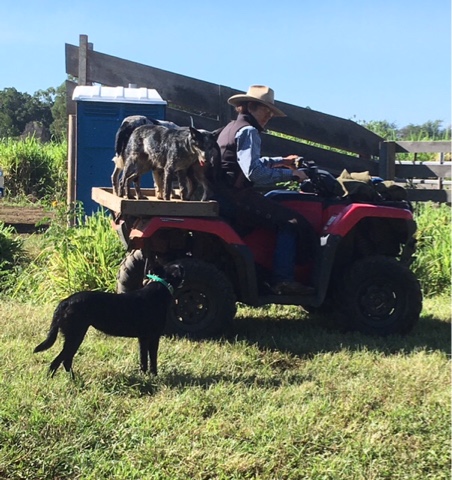I've learned that for me, under my particular circumstances, time is the most valuable and perhaps scarcest resource. I've been whining all along that if I only had more time, I could reach my goals easier and faster. So what have I done about it? Added more projects to get done. Egads girl, you must be simple minded!
I currently have two main outlets for my farm surplus. While I'm meeting the needs of the first, I'm nowhere near fulfilling the needs of the second. So I'm now on a mission to seemingly kill myself trying to expand my growing areas ASAP. Thus the reason the blog gets quiet from time to time. Simply no time to blog.
These past two weeks I've added two turmeric beds. I happened to have had about three quarts of unplanted turmeric rhizomes available for planting. I had already planted the best of the lot many weeks ago, but now here's this opportunity to expand. So after finding two 6'x8' flattish spots in the shade, I removed the ferns and grasses ( into the compost bin they go) and the surface rocks bigger than a softball. I then incorporated 1/2 cubic yard of compost/soil mix into the little bit of soil there, and shallowly planted the turmeric. Finally, covered this with 2" of chicken pen litter. It's late to be planting turmeric, but the little rhizomes were beginning to sprout, and while they won't produce sellable turmeric, they should produce fine enough stock to use for replanting next year.
My second buyer wants fresh green beans and snow peas. In response, I've created 200 sq feet of new space. Not very much, but of course it did take time...... plant removal , rock removal (anything bigger than a hen's egg), go mine soil from elsewhere and add to bed to replace the volume lost by rock removal, mix in compost and manure, test pH, add extra coral and lava sand, plant seeds, water in, go mow grass for a light mulch covering, apply mulch. All that takes time. And you know, 200 sq feet won't be enough. Sigh. I'll be doing this over and over again.
Being that I'll be growing a lot more beans and peas, then I also need the seed for planting. So down to the seed farm I go. Build 5 more pallet grow boxes. Fill them....it takes a lot of time and labor. Top them with soil/ compost mix. Sow seeds. I need several more grow boxes, but that's a start for now. If I add one new box a week for a while, I might be able to meet my seed needs as I keep increasing the square footage of growing beds.
Dummy me hadn't taken into consideration the extra harvest and processing time. Is this why some of my farmer friends either get up extra early to go process their harvests, or hire employees. No way do I plan to hire employees! Been there, done that, never doing that again, ever. But I am looking into adding a live-on-the-farm caretaker/part time farm helper. We'll see. For now I am doing the harvesting, which I deem to be a pleasant task. And the processing, which actually I also enjoy. But it takes time. Time!
I'm fully aware that adding mechanization can help relieve my time issues. I guess that's why farmers gradually add all sorts of time saving machinery, shortcuts, monoculture, and outside labor. I'm only adding things that I enjoy or at least don't cause me stress. While I'd enjoy a tractor, maintaining and repairing it would result in stress and expense. While employees would save me time and physical labor, the stress and headaches simply aren't worth it to me. Monoculture is not appealing. I have no interest in switching to commercial fertilizer or herbacides. A lot of "shortcuts" in commercial production results in much wastage, lower quality, less production per square foot, none of which fit into my scheme. And I'm not interested in eliminating polyculture, nor my multiple scattered growing beds. Stubborn old fool, for sure, am I. (Talk like Yoda, do I.)
So I guess for now I'm sticking with my plan and will work on fine tuning my efficiency. I will do what I can do while keeping things in the "enjoyable" category. And I'll just have to accept that there will be nights that I fall asleep in my lounge chair before making it into bed. As long as I enjoy this trip, I'll keep at it, but for those of you who wish to move to a small farm and "live the good life", be prepared to work and spend a lot of time doing it.






























